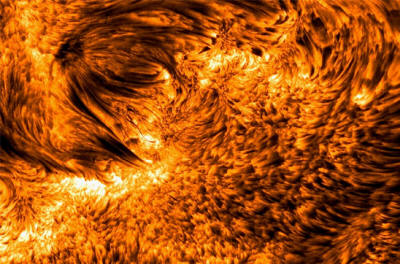|

by Stephen Smith
March 14, 2012
from
Thunderbolts Website
Spanish version

Dark
against light solar spicules in the H-alpha band.
Note that the
dark regions are "blue-shifted."
Credit:
Lockheed Martin Solar and Astrophysics Lab
Dark mode plasma phenomena exist on the
Sun.
The image at the top of the page is the most detailed ever taken of
the Sun’s chromosphere. The smallest features are 130 kilometers in
size. Each
spicule is about 480 kilometers in diameter, with a
length of 3200 kilometers. The largest measure as much as 8000
kilometers long.
Although the light and dark regions are
colorful, the colors were added in processing.
In
the Electric Sun hypothesis, the Sun is a glowing anode, or
positively charged “electrode.” The cathode is an invisible “virtual
cathode,” called the heliosphere. The heliosphere is at the farthest
limit of the Sun’s coronal discharge, billions of kilometers from
its surface, where a “double layer” isolates the Sun’s plasma cell
from the galactic plasma that surrounds it. Galactic plasma is
otherwise called the Interstellar Medium (ISM).
Electric forces occurring within the double charge layer above the
Sun’s surface are responsible for the incredibly active plasma
phenomena that we see.
Since
Electric Universe theory assumes
that celestial bodies interact through conductive plasma and are
connected by circuits, the Sun is also assumed to be
electrically
connected with the galaxy.
The Sun can be thought of as an
electrically charged object seeking equilibrium with its
environment. However, it is not stable. The charges flowing into and out of the
Sun can sometimes increase to the point where it releases plasma
discharges called solar flares.
Conventional scientists see solar flares, or coronal mass ejections
(CME), taking place when magnetic loops “reconnect” with each other,
causing a short circuit. The so-called “magnetic energy” is said to
accelerate gases into space.
Although “magnetic reconnection” is a
poorly constructed theory, it is the only explanation offered by
heliophysicists.
The “solar wind” is a dark mode emission radiating from the Sun at
approximately 700 kilometers per second. In a Universe governed by
gravity, the Sun’s heat and radiation pressure cannot explain how
the charged particles that make up the solar wind accelerate past
Venus, Earth and the rest of the planets. Prior to the discovery, no
one expected such acceleration.
In an Electric Universe, there is an obvious explanation: electric
fields in space.
Since coherent charges flow through the Solar
System, then it seems reasonable to conclude that the dark mode
solar plasma is affected by the electrodynamic fields of the Sun and
its planetary family.
Solar flares could be tremendous lightning bursts in that case,
pushing plasma to near relativistic speeds.
If the circuit that
connects the Sun with the Milky Way extends for hundreds of
thousands of light-years, massive amounts of electrical energy might
be contained in such magnetically confined “transmission lines”
feeding the solar anode.
According to the Electric Sun theory, flares, the hot corona, and
all other solar phenomena result from changes in the electrical
input from our galaxy.
Birkeland current filaments slowly rotate
past the Solar System, supplying more or less power to the Sun as
they go.
Arc mode, glow mode, and dark mode
discharges are all influenced by those flowing currents of electric
charge.
|

